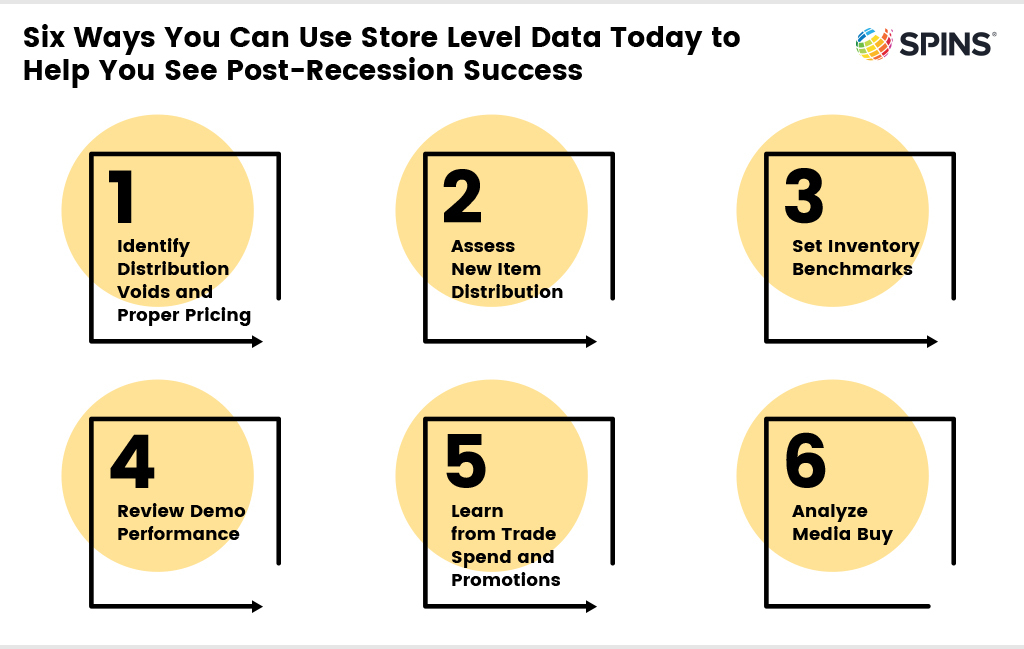Store Level Data Helps You Grab Share of Tomorrow’s Market
Even in a year filled with “unprecedented” events, grocery retail’s sequential months of aggressive growth is noteworthy, especially for natural: In March, YOY overall grocery sales were up 36% and natural sales were up 43%. Months later, in mid-July, total grocery sales were still up 15% and natural was up 19% YOY. These record-high numbers won’t last forever, but you can take steps now to attract and keep customers for the long-term.
If you want to be part of the “new normal” and maintain a place on shopping lists months and years from now, you need to dig into the data that lets you understand what is attracting customers today. You need to understand how your brand is performing across several metrics—and SPINS Store Level Data is the smartest way to achieve that. Store Level Data (SLD) gives you POS insights at each retail location you’re at, allowing you to monitor performance, test new products and promotions, and build a stronger growth strategy.
Here are 6 ways you can use Store Level Data today to help you capture today’s customers:

1) Identify Distribution Voids and Proper Pricing
With SLD, you can review your top-performing products and review where they’re being distributed and at what price point. Are your best-selling items in as many stores, natural outlets, and co-ops as possible? Are retailers selling your products at the appropriate price?
These basic data points can immediately tell you if you’re missing out on revenue and potential customers—both of which have long-term effects. Fill distribution voids so you’re reaching as many customers as possible and are on their radar as they continue post-recession shopping.
2) Assess New Item Distribution
Before you launch a new product nationally, run a test in a market or a few select markets. You can measure store-by-store performance and even look at sales per point of distribution. Adjust pricing, try new promotions, test out displays. This early stage with a concentrated test market is your best opportunity to identify and understand performance risk so you can have a successful and informed national rollout.
3) Set Inventory Benchmarks
Don’t get caught by unwelcome surprises with news of lost distribution or sales dips. For every location you’re carried in, you can use SLD to set benchmarks for every item based on performance by store and time of year. With benchmarks in place, your SPINS representative can alert you to sudden changes that could signal bigger concerns, such as supply chain backups, discontinuations, loss of prominent display due to shelf resets, or a new competitor.
4) Review Demo Performance
Demos are integral to marketing, but they’re often difficult to measure. With SLD, you can take the guess work out of demo reviews and get a closer look at the results. First, build your demo schedule and identify your pre-sales baseline. Run your demos and then review the data to identify any post-demo lift—even down to the location. You’ll get a clear picture of which demos worked, which ones recouped their cost, and which retail customers responded positively. You’ll then have data to make future demos efficient and cost-effective.
5) Learn from Trade Spend and Promotions
As with demos, many brands invest in marketing tactics but can’t often quantify their effectiveness. Trade spend, promotions, and digital coupons don’t always lend themselves to easy analysis, but SLD solves that challenge. Now, when you run a promotion and offer coupons, you can study the SLD to identify sales increases. Then you know where to double down on those tactics and where to stop or revise your approach.
6) Analyze Media Buy
Similarly, media performance is often hard to trace back to sales results because high-level data doesn’t offer the details you need to draw definitive conclusions. Store Level Data, however, lets you isolate the stores in a market and monitor performance after a trade event or a TV or radio spot. Did those stores experience a lift that the rest of the market didn’t? Was the ROI enough to justify the media buy? Use SLD to invest wisely and get your brand the most results for the spend.
We’re in the middle of an unusually robust grocery retail sales, and now is the perfect time to connect with your customers so that you’re part of their post-recession shopping habits. Store Level Data makes that easier than ever, and SPINS is ready to help. Contact us today.




